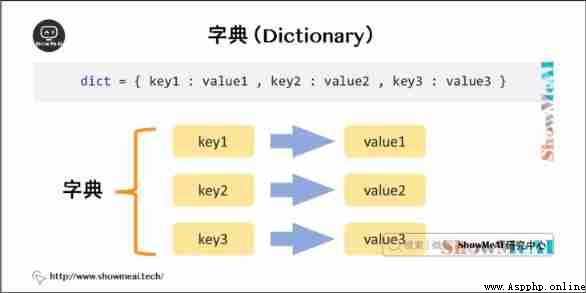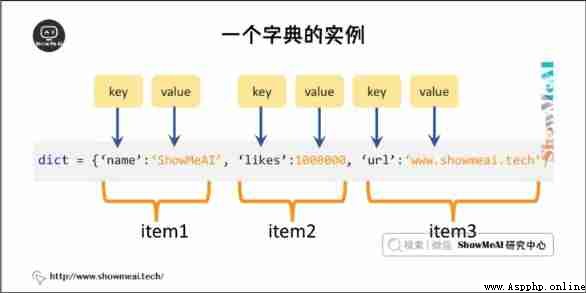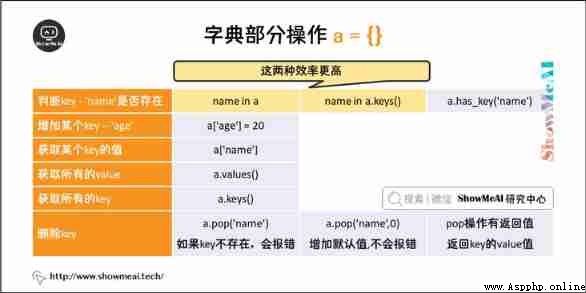
author : Han Xinzi @ShowMeAI
Tutorial address :http://www.showmeai.tech/tuto...
This paper addresses :http://www.showmeai.tech/article-detail/79
Statement : copyright , For reprint, please contact the platform and the author and indicate the source
Dictionary is another variable container model , And can store any type of object .
Each key value of the dictionary key=>value Yes, with a colon : Division , Comma between each key value pair , Division , The whole dictionary is enclosed in curly brackets {} in , The format is as follows :
d = {key1 : value1, key2 : value2 }

Keys are usually the only , If you repeat the last key value pair, the previous one will be replaced , Value doesn't need to be unique .
>>> dict = {'a': 1, 'b': 2, 'b': '3'}
>>> dict['b']
'3'
>>> dict
{'a': 1, 'b': '3'}
# dict = {'name': 'runoob', 'likes': 123, 'url': 'www.runoob.com'}
dict = {'name': 'ShowMeAI', 'likes': 1000000, 'url': 'www.showmeai.tech'}
The value can take any data type , but The key must be immutable , Such as a string , A number or tuple .
A simple dictionary example :
dict1 = {'Alice': '2341', 'Beth': '9102', 'Cecil': '3258'}
dict2 = { 'abc': 123, 98.6: 37, (1,2):345 }
Put the corresponding key in the familiar square brackets , Here's a code example ( The code can be in On-line python3 Environmental Science Run in ):
dict = {'Name': 'ShowMeAI', 'Color': 'Blue', 'Class': 'First'}
print("dict['Name']: ", dict['Name'])
print("dict['Color']: ", dict['Color'])The execution result of the above example :
dict['Name']: ShowMeAI
dict['Color']: BlueIf you access data with keys that are not in the dictionary , The output error is as follows :
dict = {'Name': 'ShowMeAI', 'Color': 'Blue', 'Class': 'First'}
print("dict['Age']: ", dict['Age'])The output of the above example :
Traceback (most recent call last):
File "<string>", line 5, in <module>
KeyError: 'Age'The way to add new content to the dictionary is to add new keys / It's worth it , Modify or delete existing keys / The value is shown in the following code example ( The code can be in On-line python3 Environmental Science Run in ):
dict = {'Name': 'Zara', 'Age': 7, 'Class': 'First'}
dict['Age'] = 8 # to update
dict['School'] = "ShowMeAI" # add to
print "dict['Age']: ", dict['Age']
print "dict['School']: ", dict['School']The output of the above example :
dict['Age']: 8
dict['School']: ShowMeAICan delete a single element can also empty the dictionary , Emptying takes only one operation .
Show delete a dictionary with del command , The following example :
dict = {'Name': 'Zara', 'Age': 7, 'Class': 'First'}
del dict['Name'] # Delete key is 'Name' The entry of
dict.clear() # Empty all dictionary entries
del dict # Delete Dictionary
print("dict['Age']: ", dict['Age'] )
print("dict['School']: ", dict['School'])But this raises an exception , Because with del The post dictionary no longer exists :
Traceback (most recent call last):
File "<string>", line 9, in <module>
TypeError: 'type' object is not subscriptablenotes :del() Methods will also be discussed later .
The dictionary value can take any python object , It can be a standard object , It can also be user-defined , But the key doesn't work .
Two important points to remember :
1) The same key is not allowed to appear twice . When creating, if the same key is assigned twice , The latter value updates the previous one , The following example :
dict = {'Name': 'Zara', 'Age': 7, 'Name': 'ShowMeAI'}
print "dict['Name']: ", dict['Name']The output of the above example :
dict['Name']: ShowMeAI2) The key must be immutable , So you can use numbers , A string or tuple acts as , So using lists doesn't work , The following example :
dict = {['Name']: 'Zara', 'Age': 7}
print("dict['Name']: ", dict['Name'])The output of the above example :
Traceback (most recent call last):
File "<string>", line 3, in <module>
TypeError: unhashable type: 'list'Python The dictionary contains the following built-in functions :
Python The dictionary contains the following built-in methods :
Please click to B I'm looking at it from the website 【 Bilingual subtitles 】 edition
https://www.bilibili.com/vide...
The code for this tutorial series can be found in ShowMeAI Corresponding github Download , Can be local python Environment is running , Babies who can surf the Internet scientifically can also use google colab One click operation and interactive operation learning Oh !
This tutorial series covers Python The quick look-up table can be downloaded and obtained at the following address :
